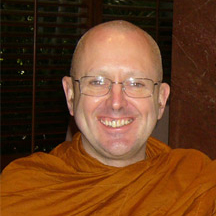Monday, May 28, 2007
Meniti Jalan Tengah
Sebuah e-mail saya terima bulan Maret lalu, info tentang retreat lima hari
bersama Master Zen Thich Nhat Hanh di Hongkong. Hati saya seketika
terangkat, intuisi saya berkata: pergi. Saya pengagum karya-karya beliau,
tapi tidak mempelajarinya secara mendalam. Bisikan kedua datang dari guru
sekaligus sahabat saya, yang juga berkata: pergi.
Bahkan hingga saya menginjakkan kaki di Hongkong pada tanggal 11 Mei lalu,
menempuh perjalanan satu jam lebih ke Wu Kai Sha, dan meletakkan koper
saya di dalam kamar yang akan dihuni bersama lima orang lain selama lima
hari ke depan, saya masih belum tahu pasti apa yang saya cari, dan apa
yang akan saya dapat.
Tercatat sekitar 400 orang yang menginap di kompleks retreat, 400 orang
datang pulang-pergi, plus 60 anggota Sangha yang didatangkan dari Plum
Village. Ini memang retreat skala besar. Hampir 900 orang berkumpul di
dalam aula setiap harinya. Suasana riuh dan tempo cepat yang membungkus
kami seketika bertransformasi seusai Thich Nhat Hanh muncul dan memberi
orientasi tentang "Five Mindfulness Trainings" yang akan kami jalankan
selama retreat. Tidak hanya dalam bentuk penjelasan tapi juga pengalaman
langsung yang akan dijalankan lewat meditasi berjalan, meditasi duduk,
makan, minum teh, bicara secukupnya, dibantu oleh energi kolektif Sangha
yang hadir membaur dengan para peserta.
900 orang lalu mulai bergerak dalam keheningan, dalam tempo lambat, dengan
bungkukan hormat dan tangan berpose anjali, diiringi bunyi bel yang
sesekali digaungkan untuk mengingatkan semua orang berhenti beraktivitas
dan pulang pada irama napasnya. Lambat laun saya mulai memahami mengapa
saya memilih pergi.
Sungguh, tidak ada kegiatan "luar biasa" yang saya lakukan di sana. Kami
sarapan, bermeditasi duduk dan berjalan, mendengarkan ceramah, makan
siang, istirahat, berdiskusi dalam kelompok kecil saat sore, makan malam,
tidur. Namun hidup seolah-olah ingin menunjukkan bahwa sesungguhnya setiap
hari adalah ritual kesadaran. Dan kita telah melewatkan kegiatan-kegiatan
sederhana ini bagai angin ribut yang menyapu padang bunga. Angin yang
berlomba menuju ruang kosong tanpa tahu banyaknya keindahan yang gugur di
bawah sana. Dan selama lima hari kami dilatih untuk menahan laju angin
badai ini, kembali menjadi udara yang bergerak semilir agar sempat
memetiki bunga-bunga cantik yang selama ini tumbuh tanpa disadari di
padang hidup kita.
Pemamahan itu pun terus membulat dari hari ke hari. Mulai saya mengerti
mengapa guru saya menyuruh saya pergi. Pada bulan Maret, beberapa hari
sebelum info tentang retreat tersebut tiba, saya terlibat percakapan
dengannya, dan Sang Guru berkata: Remember that nature isn't just about
drives and impulses. Reality shouldn't be perceived as all restriction or
compromise, but as a pathway to ensure your safety towards your highest
purpose. And as the middle path walker you should be aware of the dynamic
between your inside and the outside world. To walk safely and respectfully
means you take both realms into consideration. Dan ketika saya bertanya
balik, koridor apa yang harus saya pakai, jawabannya singkat saja: five
precepts.
Lima Sila ini telah digaungkan Sang Buddha sejak 2500 tahun lalu, sekilas
pintas tak jauh berbeda dengan Ten Commandments, atau nasihat standar
orang tua: Jangan membunuh. Jangan mencuri. Jangan berbohong. Jangan
berbuat asusila. Jangan mengonsumsi apa pun yang melemahkan kesadaran. Dan
terkadang, dengan konteks zaman yang jauh berubah, pola pikir yang
memodern dan kian canggih, sungguh tidak mudah mengerti kedalaman
perintah-perintah singkat itu, bahkan terasa naif dan tidak realistis.
Kita sering lupa, bahwa penderitaan dalam kehidupan manusia, begitu juga
kebahagiaan yang didamba semua manusia tetap sama, terlepas dari zaman
Abraham manusia naik unta dan sekarang manusia terbang dengan Boeing.
Lebih riskan lagi, terkadang kita terjebak dalam pencerahan sebagai
momentum. Kita lupa bahwa menjadi tercerahkan melibatkan disiplin dan
praktek yang dijalankan seumur hidup. Kita tersesat dalam "spiritual"
sebagai konsep tinggal telan, dan mengabaikan aspek "spirit" yang tak
lepas dari "ritual".
2500 tahun telah berlalu, guru-guru yang merupakan emanasi dari
kebijaksanaan Sang Buddha telah hadir dan pergi, dan saya bersyukur dapat
bertemu dan berpraktek langsung dengan salah seorang guru yang berhasil
menerjemahkan Lima Sila ke dalam pengertian modern. "Five Mindfulness
Trainings" yang dirumuskan Thich Nhat Hanh tak lain adalah penerapan Lima
Sila dalam konteks zaman sekarang, sebagaimana bernamaskara dijembataninya
menjadi ritual bersyukur pada bumi, orang tua, dan leluhur. Triratna
dijembataninya menjadi ajaran cinta kasih, pemahaman benar, dan komunitas
yang harmonis. Pada saat itu baru saya mampu mengapresiasi apa yang telah
dilakukan Thich Nhat Hanh selama ini. Beliau mampu menghidangkan kemurnian
ajaran Dharma dalam kemasan masa kini, tanpa mengintimidasi, tanpa
kehilangan otentisitas.
Sejak lama saya menerima dan menyepakati ajaran Sang Buddha. Namun
Mindfulness Retreat menjadi titik balik bagi saya. "Five Mindfulness
Trainings" bukan kesaktian atau momen tunggal pencerahan yang
sekonyong-konyong menghajar kesadaran, melainkan komitmen harian dan kode
etik yang, jika dijalankan dengan setia, niscaya akan membuahkan mental
yang bersahaja, bermakna, dan peka. Sesuatu yang masuk akal dan konkret
untuk mewujudkan hidup damai yang didamba semua makhlukterlepas apa pun
bentuk dan keyakinannya. Bagi saya, koridor tersebut relevan untuk konteks
hari ini dan relevan pada setiap masa.
Hari terakhir retreat. Sejak pukul setengah enam pagi semua peserta
berkumpul dalam aula. Kami, yang memilih untuk berkomitmen pada lima
praktek kesadaran, duduk berlutut. Dan saat saya bernamaskara, mengucapkan
komitmen saya, hati sayalah yang sesungguhnya bersujud mensyukuri
setidaknya tiga hal. Pertama, saya berkesempatan terlahir menjadi manusia.
Kedua, saya berkesempatan mengenal ajaran kebenaran dan kasih. Ketiga,
saya berkesempatan untuk meniti jalan tersebut.
Kita dapat berdiri jauh dari jalan itu, membayangkan untuk meraihnya satu
hari tanpa menggerakkan satu pun kaki. Kita dapat berdiri begitu dekat
dari mulut jalan, tapi kabut tebal menghalangi pandangan hingga kita
berdiam lama tanpa berbuat apa-apa. Kita dapat melancong ke tepi jalan
itu, berfoto sejenak, lalu pergi untuk menambah koleksi tempat-tempat
wisata kita. Dan kita dapat pergi ke jalan itu, menitinya perlahan,
langkah demi langkah, tanpa terbebani iming-iming yang menanti di ujung
sana, dan hanya mengapresiasi komitmen dan upaya kecil kita setiap hari.
Memetiki bunga-bunga mungil yang selama ini terabaikan, menahan laju angin
badai yang senantiasa menggusur kaki ini keluar dari koridor. Jalan Tengah
dicari bukan hanya demi filosofi, tapi bukti untuk dijalani.
Teks "Five Mindfulness Trainings" saya renungkan berkali-kali selama
retreat, bahkan saya menangis jika perlu. Ada keindahan yang tak
tertampung tubuh ketika pemahaman ini mengutuh. Perjalanan hidup saya…
pertemuan saya dengan sahabat sekaligus guru saya… hingga selembar tiket
elektronik yang menerbangkan saya ke Hongkong… tampak sebagai rangkaian
penggalian untuk kembali menemukan apa yang telah tertimbun oleh debu
batin dan waktu: vajrapermata yang bersemayam dalam diri. Terakhir, saya
bernamaskara bagi mereka, bagi kalian, bagi kita, bagi semua makhluk, yang
dengan caranya masing-masing telah menjadi guru terbaik saya.
* Teks lengkap dari "Five Mindfulness Trainings" dapat dilihat di situs
resmi Plum Village:
www.plumvillage.org The most prominent colour concept in Buddhism is that of the rainbow body, which is the highest level of meditative achievement wherein the body is transformed into pure light. The rainbow body is the highest achievement other than Nirvana, which is the essential end-goal for Buddhists. Since the “pure light” on the spectrum contains all colors, and is white, to possess a rainbow body means to possess all colors, and to do some means meditating on colors that embody specific teachings.
The most prominent colour concept in Buddhism is that of the rainbow body, which is the highest level of meditative achievement wherein the body is transformed into pure light. The rainbow body is the highest achievement other than Nirvana, which is the essential end-goal for Buddhists. Since the “pure light” on the spectrum contains all colors, and is white, to possess a rainbow body means to possess all colors, and to do some means meditating on colors that embody specific teachings.




